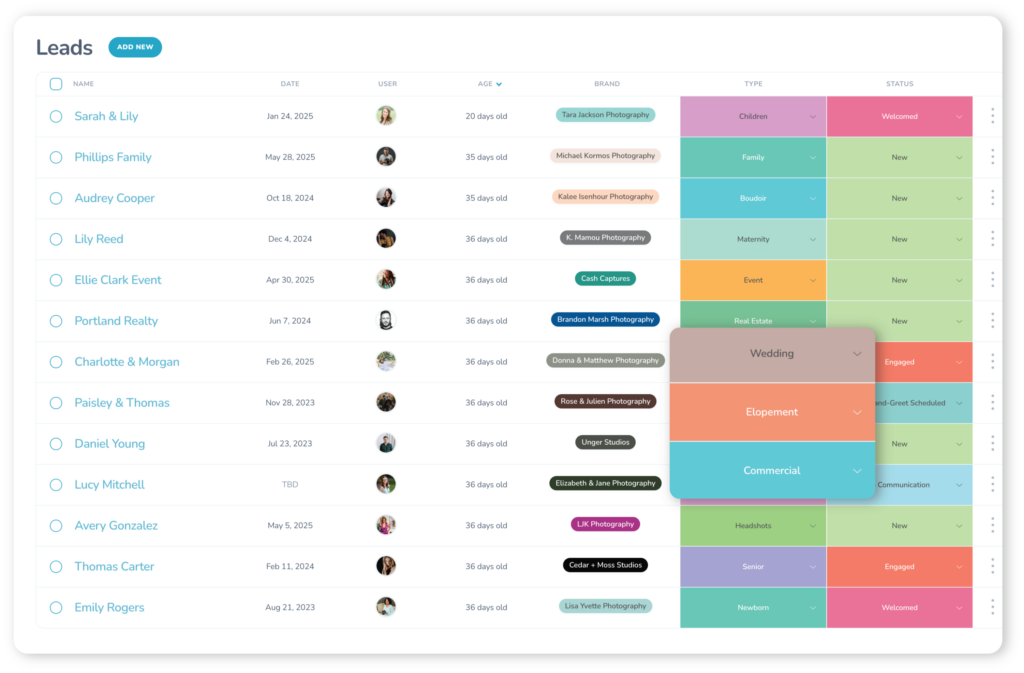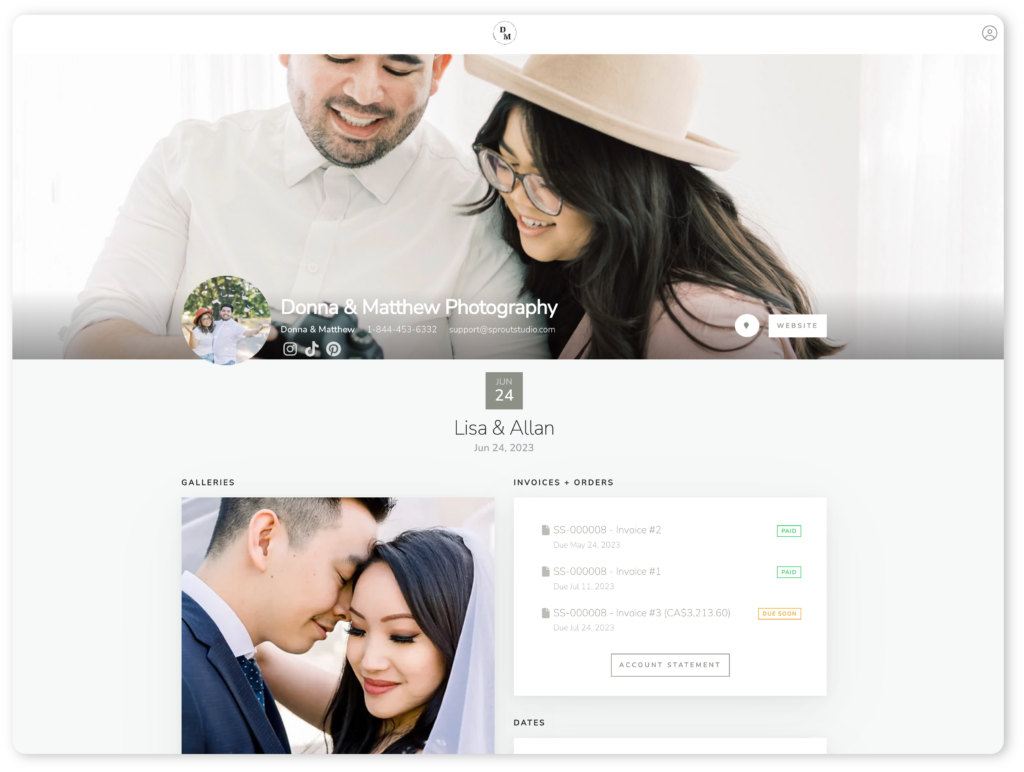Last week, I published an article titled “How to sell a wedding album to every couple” and in it, I promised a follow-up article about how you can use sample albums as a sales tool in your photography business. One of my first articles was titled “Boost Your Photography Sales: Learn How Sample Wedding Albums Can Skyrocket Your Business” where I talked about why it’s important to have sample albums in your studio.
Today, I will talk more about the how-to mechanics of sample albums and how you can use them as a sales tool in your photography studio.
There are 6 steps to follow in order to make the most of sample albums as a sales tool in your studio. If you follow them when planning your samples, you will ultimately see three core benefits in your business right away:
- You will book more couples.
- You will sell more albums.
- You will more effectively set your clients’ expectations.
A word about “selling”
The small mindset shift you must make
Let me preface the discussion by saying that before you apply the 6 principles to turn sample wedding albums into a sales tool, you must get “on board” and follow the practices that I outlined in last week’s article. If you haven’t read that article yet, I’d suggest that you head on over and do so now, because having samples is only one piece of the puzzle in order to effectively sell albums to your clients.
Let me also say that any and all ideas here (and previously) about “selling” must always be implemented with the right mindset. There’s no “magic bullet” in selling, and you can’t use techniques, tricks and tactics to “slime” your way into a sale. Selling isn’t about forcing what you want on your clients, but instead it’s about helping your client get what they want. There’s a fine-line between manipulation and persuasion, and it’s one that needs to be clearly defined. Here’s how you can always approach “selling” with the right intent – be honest, genuine, always act with integrity and think with a “client-first” mindset.
As a re-cap, the foundations to selling albums are as follows:
- Give couples something that they can’t get themselves.
- Make it easy for them to buy.
- Believe in the importance of albums yourself.
- Make albums a big part of your client flow.
- Use the right language when talking about albums.
Now let’s get real specific with regards to sample albums.
6 principles
How to use sample albums as a sales tool
Principle #1: One wedding per album
Many photographers will have sample albums that are a collection of several weddings, or a “best of” from the previous year, but I recommend against this. Instead, have one wedding per album, and design it as if it were a client’s album. This helps your prospective brides visualize what their album will look like, and it shows the quality of your work and your storytelling abilities in the context of one wedding.
I personally make it a point in my studio to only have sample albums that are copies of albums that I have done for my past brides, instead of designing a specific sample album. This benefits me in a number of ways:
- Saves time: I don’t have to design new sample albums from scratch each time, but instead just order copies when I am ordering an album for a client that I love.
- Sets expectations: By having copies of past clients’ albums on display, I can rest assured that I am showing new and prospective clients a true representation of exactly what I’ll be able to do for them.
- Proof: When I am showing new and prospective clients my sample albums, I make a point to tell them that what they’re looking at is a duplicate copy of a past couple’s actual wedding album. This is “proof” that past clients do order these big beautiful albums, and it signals to the new or prospective client that this is what couples who work with me get.
Principle #2: Have many samples
Any photographer who has been to my studio knows that I love sample albums; I have a ton of them. I do it for a reason, though, and that is to have variety in what I can show to new and prospective clients. In a meet-and-greet (a.k.a. the consultation – listen to this episode of the podcast to know why I call it a meet-and-greet) I will usually only pull out one album to show the couple, but I will pull out an album that is relevant to them, and the only way I can do this is by having many samples.
My suggestion would be to ensure you have many albums, all that are:
- From different venues in the area that you photograph at often.
- Feature different vendors who were involved in the wedding day.
- Varied in styles (leather, cover choice, page thickness, binding, etc).
- Different styles of weddings (outdoor, tent, hall, vintage, backyard, etc).
Three examples of where having many sample albums is a benefit:
Example #1: You are in a meet-and-greet and the couple has said that they’re having an outdoor garden ceremony, followed by a casual tent reception, then you should pull out a sample album that would best suit them (i.e. a garden ceremony and a tent reception) and not show them an album from a wedding that was in a large church followed by a reception in a traditional large hall.
Example #2: You are talking with a couple and they said that they had hired a specific florist and decorator, then you should show them some direct examples of that florist and decorator’s work. This not only makes you relevant to the couple, but it shows off the florist and decorator’s work (extra points for that) and shows that you’re “in the know” in the industry, positioning you as an expert and/or leader.
Example #3: The couple in a meet-and-greet tell you that their reception hall is at a specific venue, wouldn’t it be great to show them a wedding that took place at that specific venue? Again, it shows that you have familiarity with the venue, are relevant and have great experience.
I love the idea of being specific like with our couples, because when we can be genuinely interested in them, show them that we are listening and be directly relevant to them, their needs and their wedding plans, we can establish credibility quicker and begin to build a relationship that transcends just our photographic abilities.
As a side-note: As mentioned, I also think it’s important to have sample albums that show off the different options of albums that you have to offer. It’d be hard to describe a beautiful flushmount, thick-page, leather-bound album if all you had were coffee-table style fine-art photo-cover books. Have a variety of the options to show, so that again, you can be relevant and specific. If a couple indicates to you that they prefer classy, simple and traditional albums, then don’t show them an album with a funky cover or jewels all over the side. There’s no better way to “kill the sale” than by showing them something that they don’t like the style of and turn them off all together.
Principle #3: Display sample albums prominently
If you want to sell albums, you have to show them. If you want to make them a big part of what you do, then you need to prominently display them in your studio and meeting space. My recommendation is simple – display them in one central location, and be particular about how you place them and lay them out. Have some albums laying flat, some standing up straight, some with their spine showing, etc.

There is a lot attention that goes into merchandising book store displays. Think about it, some books are “featured” with their face-out, others are stacked while others are shown with their spine out. Consider your album display table or shelf as a really fancy (and expensive) bookstore, and merchandise your albums to be visually pleasing.
Principle #4: Show your signature style
The next three tips have more to do with album design than sample albums themselves, but they are important principles designing your sample albums.
Be sure to show off your signature style (or your USP) in your albums. Have lots of large images and smaller sequences that tell a story. Remember that any new or prospective client in your studio who is looking at the sample album only has the 20 pages (or however many pages you have in your albums) to get the “feel” for your style and your quality of work in the context of that wedding. Hit them with impact, emotion, mood and beauty and be sure that every one of your sample albums can stand on it’s own.
Principle #5: Make your albums about the pictures
The point needs to be re-iterated: new or prospective clients looking through your sample album only have 20 pages to make up their mind about your style, your storytelling abilities and your creativity in the context of that wedding. Don’t clutter their minds and eyes with crazy design elements, tilted images or silly borders.
This is certainly a design preference, but my recommendation would be to keep your albums more about the pictures in the album and less about the layout of those pictures. Keep your design simple, elegant, timeless and clean, and let your work speak for itself.
This will help with your visual storytelling ability, and also in the impact your sample albums can make to someone looking through it for the first time.
Principle #6: Attach stories to images
Attach stories to images, sequences and pages in the album so that as the couple is flipping through the sample album, you can strategically tell a narrative or background about that particular image or page. This breathes new life into your work through the eyes of your clients, and gives you an excuse to bring up certainly topics of conversation (in the form of stories) that you may not have otherwise brought up.
Substitute “Wedding Album” for “Portrait Book”
Much of the discussion here has been about wedding albums, but it’s important to note that any and all of these ideas are directly transferable to any other industry or album/book. If you’re a newborn photographer wanting to sell more newborn books to your clients, just substitute the word “album” for “book” and “bride” or “groom” for “Mom-to-be” or “Dad-to-be” and you have a recipe for success! Likewise for boudoir books, family portrait books, engagement books, and so on.













